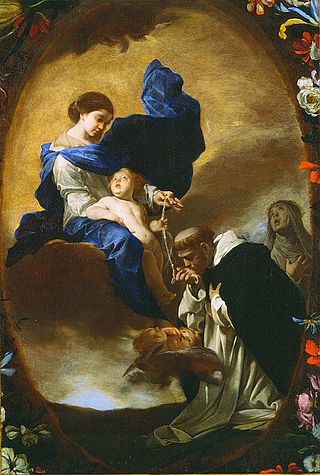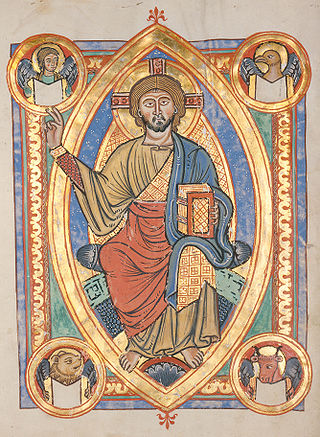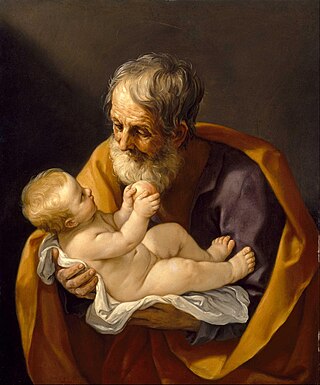| |
| Part of a series on |
| Josephology of the Catholic Church |
|---|
 |
| General articles |
| Prayers and devotions |
| Organisations |
| Papal documents |
| |
The following are Roman Catholic prayers to Saint Joseph.
| |
| Part of a series on |
| Josephology of the Catholic Church |
|---|
 |
| General articles |
| Prayers and devotions |
| Organisations |
| Papal documents |
| |
The following are Roman Catholic prayers to Saint Joseph.
Joseph, the silent man of the Gospels, is in the line of the great men of faith of the Old Testament. He is described as a "just man", a righteous man of integrity. He is in the tradition of Abraham who was called by God to "walk before my face and be upright (Gen: 17.1);and of Moses who was told to be "entirely sincere", "entirely faithful" (Deut: 18.13). For centuries his place in the story of Jesus was comparatively unnoticed. Gradually, in Catholic tradition, he was recognised as patron of fathers of families, of bursars and procurators, of manual workers, especially carpenters, and of all who desire a holy death. [1]
The parish in Buenos Aires where Pope Francis grew up is dedicated to San José. Solemnly inaugurated on 19 March 2013, Francis’ pontificate is placed under the protection of Saint Joseph. One of the few things the Pope had sent over from Argentina after his election is a statue he had. It depicts the saint lying down asleep, a reference to the gospel accounts of Saint Joseph receiving the counsel of angels in several dreams. The Pope slips pieces of paper with prayer requests under the pedestal of the statue, which is just outside his room at St. Martha's House. [2]
“You know,” said Francis, “you have to be patient with these carpenters: they tell you they’ll have a piece of furniture finished in a couple of weeks and it ends up taking a month even. But they get the job done and they do it well! You just need to be patient…” [2]
The purpose of Pope Leo XIII's 1889 encyclical Quamquam pluries was to implore divine help by means of prayer, joining to the intercession of Mary that of Saint Joseph. Leo XIII therefore attached to his encyclical a special Prayer to Saint Joseph requesting that it be added to the recitation of the Rosary during the month of October.
The encyclical Quamquam pluries established the Prayer to Saint Joseph is mandatory to be recited at the end of each holy Rosary recited during the Marian Month of October. The prescription is forever (in Latin: perpetuo idem servetur) and thus it can't be deleted by any subsequent Vatican document. It causes an indulgence of seven years and seven Lents. Moreover, it is recommended, even if not mandatory, in the three days preceding March 19, the day in which the Solemnity of St Joseph takes place. [3]
The Prayer to St Joseph may be said after the customary Salve Regina and concluding prayer. It may also be used to conclude other Marian devotions. [4]
The litany of Saint Joseph was sanctioned by Pope Pius X in 1909. After the usual petitions to the Holy Trinity and one to the Blessed Virgin, the litany is composed of twenty-five invocations expressing the virtues and dignities of Joseph. [5]
Furthermore, Pius X composed a Prayer to Saint Joseph the Worker for the sanctification of labor. [6] [7]
A very old and beautiful invocation to Saint Joseph is traditionally prayed for nine days before the Feast of Saint Joseph, starting on March 10. It is found in many places, [8] [9] and was released in 1950 with the Imprimatur of the Bishop of Pittsburgh, Hugh C. Boyle. It is used in novenas, according to the text after the prayer, and the prayer text specifically seems to limit it to "spiritual blessings".
Older copies of the prayer, sometimes contain an additional comment that,
However, the year 50 A.D. is a very early date for a published prayer, preceding much of the New Testament, which does not mention very much about the father of Jesus. The statements about the year 50 A.D. and regarding the Pope and Emperor are not supported.
"Dear Guardian of Mary" is a hymn written in honor of Saint Joseph by Frederick William Faber in 1863. [10]

The Rosary, also known as the Dominican Rosary, refers to a set of prayers used primarily in the Catholic Church, and to the physical string of knots or beads used to count the component prayers. When referring to the prayer, the word is usually capitalized ; when referring to the prayer beads as an object, it is written with a lower-case initial letter.

The Most Sacred Heart of Jesus is one of the most widely practised and well-known Catholic devotions, wherein the heart of Jesus is viewed as a symbol of "God's boundless and passionate love for mankind". This devotion to Christ is predominantly used in the Catholic Church, followed by high-church Anglicans, Lutherans and some Western Rite Orthodox. In the Latin Church, the liturgical Solemnity of the Most Sacred Heart of Jesus is celebrated the third Friday after Pentecost. The 12 promises of the Most Sacred Heart of Jesus are also extremely popular.

The epiclesis refers to the invocation of one or several gods. In ancient Greek religion, the epiclesis was the epithet used as the surname given to a deity in religious contexts. The term was borrowed into the Christian tradition, where it designates the part of the Anaphora by which the priest invokes the Holy Spirit upon the Eucharistic bread and wine in some Christian churches. In most Eastern Christian traditions, the Epiclesis comes after the Anamnesis ; in the Western Rite it usually precedes. In the historic practice of the Western Christian Churches, the consecration is effected at the Words of Institution though during the rise of the Liturgical Movement, many denominations introduced an explicit epiclesis in their liturgies.

The "Salve Regina", also known as the "Hail Holy Queen", is a Marian hymn and one of four Marian antiphons sung at different seasons within the Christian liturgical calendar of the Catholic Church. The Salve Regina is traditionally sung at Compline in the time from the Saturday before Trinity Sunday until the Friday before the first Sunday of Advent. The Hail Holy Queen is also the final prayer of the Rosary.

The Novena of Grace is a Catholic devotion in honor of Saint Francis Xavier. It is usually performed from March 4 to March 12.

Catholic devotions are particular customs, rituals, and practices of worship of God or honour of the saints which are in addition to the liturgy of the Catholic Church. The United States Conference of Catholic Bishops describes devotions as "expressions of love and fidelity that arise from the intersection of one's own faith, culture and the Gospel of Jesus Christ". Devotions are not considered part of liturgical worship, even if they are performed in a church or led by a priest, but rather they are paraliturgical. The Congregation for Divine Worship at the Vatican publishes a Directory on Popular Piety and the Liturgy.
In Roman Catholicism, the morning offering is a prayer said by an individual at the start of the day in order to consecrate oneself to Jesus Christ. The practice has traditionally been associated with the Apostleship of Prayer. While since 1929 the Pope has added a general and a mission intention to the traditional morning offering prayer each month, Pope Francis has restored this to the original, single monthly intention. Over time other forms of the morning offering prayer have been suggested.

The Holy Face of Jesus is a title for specific images which some Catholics believe to be miraculously formed representations of the face of Jesus Christ. The image obtained from the Shroud of Turin is associated with a specific medal worn by some Roman Catholics and is also one of the Catholic devotions to Christ.

Thanksgiving after Communion is a spiritual practice among Christians who believe in the Real Presence of Jesus Christ in the Communion bread, maintaining themselves in prayer for some time to thank God and especially listening in their hearts for guidance from their Divine guest. This practice was and is highly recommended by saints, theologians, and Doctors of the Church.

Prayer in the Catholic Church is "the raising of one's mind and heart to God or the requesting of good things from God." It is an act of the moral virtue of religion, which Catholic theologians identify as a part of the cardinal virtue of justice.

Catholic tradition includes specific prayers and devotions as acts of reparation for insults and blasphemies against Jesus Christ and the Holy Name of Jesus. These include the sufferings during the Passion of Jesus. Similar prayers as Acts of Reparation to the Virgin Mary and Acts of Reparation to The Holy Trinity also exist.

May devotions to the Blessed Virgin Mary refer to special Marian devotions held in the Catholic Church during the month of May honoring Mary, mother of God, as "the Queen of May". These services may take place inside or outside. A "May Crowning" is a traditional Roman Catholic ritual that occurs in the month of May.

The Mariology of the popes is the theological study of the influence that the popes have had on the development, formulation and transformation of the Roman Catholic Church's doctrines and devotions relating to the Blessed Virgin Mary.

A number of prayers to Jesus Christ exist within the Roman Catholic tradition. These prayers have diverse origins and forms. Some were attributed to visions of saints, others were handed down by tradition.

Saint Louis de Montfort's Prayer to Jesus is a reflection of his philosophy of "total consecration to Jesus Christ through Mary", a theme that centuries later influenced the development of Roman Catholic Mariology.

The Scapular of Saint Michael is a Roman Catholic devotional scapular associated with Michael, the Archangel and originated prior to 1878. It was formerly the badge of the now defunct Archconfraternity of the Scapular of Saint Michael.

The Alliance of the Hearts of Jesus and Mary refers to the historical, theological and spiritual links in Catholic devotions to the Sacred Heart of Jesus and the Immaculate Heart of Mary.

Spiritual communion is a Christian practice of desiring union with Jesus Christ in the Eucharist. It is used as a preparation for Mass and by individuals who cannot receive holy communion.

Redemptoris Custos is the title of an apostolic exhortation by Pope John Paul II on Saint Joseph. It was delivered on August 15, 1989 in Saint Peter's Basilica in Rome on the occasion of the centenary of Pope Leo XIII's encyclical Quamquam pluries.

Josephology is the theological study of Joseph, the husband of Mary, mother of Jesus. Records of devotions to Joseph go back to the year 800 and Doctors of the Church since Thomas Aquinas have written on the subject. With the growth of Mariology, the theological study of Joseph also grew and in the 1950s specific centers for it were formed. The modern study of the theology concerning Joseph is one of the newest theological disciplines.
{{cite web}}: CS1 maint: bot: original URL status unknown (link)